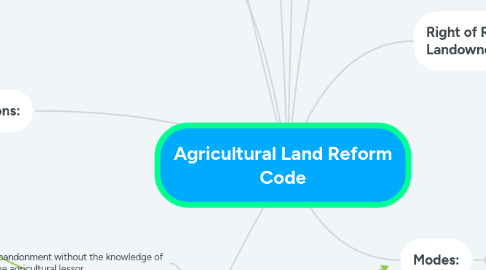
1. Title:
1.1. Also known as Republic Act No. 3844 or the Code of Agrarian Reform
2. Inclusions:
2.1. The main objective of the law to create a form of cultivatorship by the owner of a land and to spearhead the Philippine Agriculture.
2.1.1. Throughout the years, the abolished and created a lot more benefits such as the SHARE TENANCY SYSTEM, but was also replaced by the leasing of agriculture, which was deemed to be more beneficial.
2.1.2. It includes the following:
2.1.2.1. That it shall apply to all agricultural lands that are tenanted
2.1.2.1.1. P.D. 27 - Tenant Emancipation Act (retained areas)
2.1.2.1.2. R.A. 6657- CARP (Retained Areas)
2.1.2.1.3. CARP - those lands not yet acquired for distribution (Tenanted Agricultural Lands)
2.1.2.1.4. All of the tenanted areas under CARP (Section 10)
3. Exemptions:
3.1. As against Agricultural Lands, these shall be considered as exempt from Liens and Executions as well
3.1.1. 25% of the produce produced by the cultivated land
3.1.2. Owned by the Agricultural Lessee - Work animals and farm implements
3.1.2.1. the value of these should not exceed PHP 1,000
4. Limitations:
4.1. Any landholdings acquired by under RA 3844 may not be resold, mortgaged, encumbered or transferred within 10 years from the date of payment and acquisition
4.1.1. except in cases of hereditary successions
4.1.2. or in favor of those qualified to own family size farms (economic)
4.2. no article in this code or other types of property shall be exempt from execution issued upon a judgement recovered for its price or one that is upon a judgement of foreclosure of a mortgage thereon
4.3. The limitations imposed by law on the persons right to acquire property shall be observed - i.e. prohibition on the acquisition of property.
5. Extinguishment:
5.1. abandonment without the knowledge of the agricultural lessor
5.2. Absence of persons to succeed the lessee, in event of permanent disability or death
5.2.1. if in case of death of the agricultural lessee, as a mode of extinguishment, during the agricultural year - such choice shall be exercised at the end of the agricultural year.
5.2.2. If in case of the death or permanent disability of the agricultural lessor - the leasehold shall bind his legal heirs
5.2.3. WHO CAN SUCCCEED THE LESSEE:
5.2.3.1. next eldest descendant in order of age
5.2.3.2. surviving spouse
5.2.3.3. eldest direct descendant (consanguinity)
5.3. Voluntary surrender of the landholding by the lessee
6. Provides for the following:
6.1. a. an agricultural leasehold system to replace existing tenancy systems in agriculture
6.2. b. the establishments of the Land Authority for the acquisitions and distributions of lands (equitably)
6.3. c. machinery to provide for marketing, management, and other technical services to agricullture
6.4. d. to create a unified administration of all sorts of formulation and implementation of the projects for land reform
6.5. e. to create the machineries to extend credit and similar assistance to agriculture
6.6. f. the declarations of the different rights of a landowner
7. Effectivity Date:
7.1. It took effect on August 8, 1963
8. Right of Retention of the Landowner
8.1. The land or the lessor of the agricultural land shall retain ownership of the subject landholding (Under the Leasehold Tenancy)
8.2. Nothing prevents the landowner from donating the naked title to the land, but it provides that the new owner must respect the rights of a tenant.
8.3. as landowner, he exercises rights or the privileges of an owner, such as the right of retention and the right to alienate or dispose of such property without limitations except as those provided for under the law.
9. Modes:
9.1. How to acquire the ownership over the lands are as follows: (landowners can purchase these freely and voluntarily)
9.1.1. Sale
9.1.2. Donation
9.1.3. Succession - as devisee to the testator
9.2. By operation of law
9.2.1. Right of Pre-emption
9.2.2. Right of Redemption
